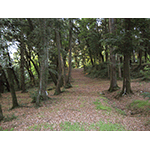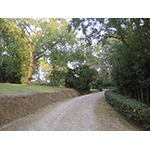Villa di Bibbiani Garden
The complex of Villa Bibbiani on the southern slopes of Montalbano, dates to the 17th century when the Frescobaldi family extended their lands north of the Arno, until reaching the border with the Villa Medici at Artimino. In 1790, it became property of Anastasia Frescobaldi on the occasion of her wedding to Pietro Ridolfi, and in 1809 was inherited by their son Cosimo Ridolfi who created one of the most important acclimatisation gardens in Italy, particularly interesting from the botanical viewpoint.
In creating the park, Ridolfi relied on his competence in botany and agriculture which led him first to become member, and then director of the Accademia dei Georgofili of Florence from 1842 to 1865. The excellent climatic conditions and favourable location led him to destine the southern part of the property to cultivations and the northern part to an English garden. The wealth and rarity of the plant species were admired by Targioni Tozzetti and Savi, in addition to the botanists who met at Villa di Bibbiani in 1841 during the Third Meeting of Italian Scientists, and by the participants in the 1858 conference of the Tuscan Horticultural Society, as a plaque in the garden recalls.
The twenty-hectare park develops over three slopes, organised into Italian gardens in the area around the villa, and into woods and meadows in the other areas. The large tree-lined lawn in front of the villa has an umbrella pine 25 metres high with a circumference of 4.4 metres, several cedars of Lebanon, a gigantic sequoia, a Caucasian fir, and a Hovenia dulcis from China, which was one of the first introduced into Italy. The Italian gardens surrounding the villa are organised into two sectors, of which the raised garden is dominated by two fine palm trees. From the botanical viewpoint, the garden behind the villa is the most important part, as it was one of the areas where Ridolfi conducted his experiments with ornamental exotic species. Here we can still admire a twisted lime tree, two pink horse chestnuts and a camphor tree, and two beds of camellias which constitute a worthy testimony of the collection Ridolfi planted around 1830. The romantic park is divided into eastern and western sections. The particularly fascinating eastern park is the site, behind an old kiln, of a splendid sequoia and a large pine, already cited in 1824, of which only the trunk remains today because of a storm in the spring of 2003. The western park, recovered in 2003, is characterised by numerous species, including a gigantic plane tree, an incense-bearing cedar, a black pine from Calabria, and a majestic umbrella pine. This area of the park is the location of a conifer nursery and a chestnut grove. Particularly interesting is the large medieval ice house, used to preserve foodstuffs until approximately 200 years ago.
The Villa Bibbiani complex is currently property of the Del Gratta family who tended to the extensive rehabilitation of recent years, and compiled a catalogue of the park’s tree species.
****************************
Texts by Graziano Magrini
English translation by Victor Beard
Last update 14/feb/2008





